Get free scan and check if your device is infected.
Remove it nowTo use full-featured product, you have to purchase a license for Combo Cleaner. Seven days free trial available. Combo Cleaner is owned and operated by RCS LT, the parent company of PCRisk.com.
What is "Gmail Virus"?
There are many spam email campaigns that are used by scammers who attempt to trick people into providing sensitive details and personal information (logins, passwords of various accounts, credit card details, and so on).
Typically, the emails are presented as legitimate and official - cyber criminals (scammers) pose as representatives of well-known companies/services. In this case, Google Gmail.
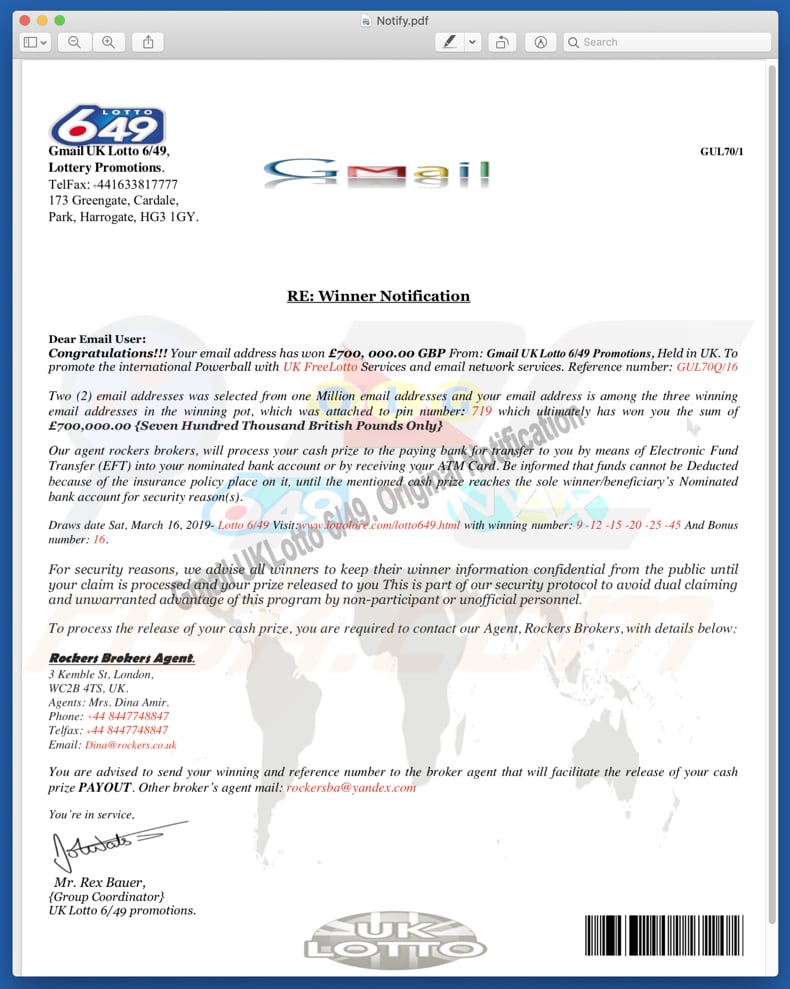
"Gmail Virus" overview
An example is "Gmail UK Lotto 6/49". This scam attempts to trick recipients into believing that their email addresses were selected as winners of a significant sum of money (£700,000.00). In this case, they are encouraged to claim their prize by contacting "agents" via the email address or telephone numbers provided.
Once contacted, the scammers behind this spam campaigns will attempt to obtain personal information such as banking account details. In other cases, people might be encouraged to open fake websites (which seem official) and provide personal details. For example, log into an account by providing their actual usernames/IDs and passwords.
These emails might contain attachments or website links that, once opened, download and install various malicious programs. These programs are also used to generate revenue by stealing personal details. Scammers generally send identical emails to many people hoping that someone will fall for the scam.
They design their spam campaigns to make it appear as if only individuals are the recipients of the email message. In this, they try to give the impression that the email is personal. Recipients are encouraged not to contact anyone about having received such an email.
For example, scammers advise people to keep their winner information confidential until the claim is processed, and so on. They do this to minimize the risk of being exposed.
Many fake winner notifications, lotteries, surveys, and other similar scams mention the Gmail service, however, Google has nothing to do with any of these scams and none can be trusted. An example of another scam distributed using the Google name is "Google Winner".
| Name | Gmail Virus. |
| Threat Type | Phishing, Scam, Social Engineering, Fraud. |
| Symptoms | Unauthorized online purchases, changed online account passwords, identity theft, illegal access of the individual's computer. |
| Distribution methods | Deceptive emails, rogue online pop-up ads, search engine poisoning techniques, misspelled domains. |
| Damage | Loss of sensitive private information, monetary loss, identity theft. |
| Malware Removal (Windows) |
To eliminate possible malware infections, scan your computer with legitimate antivirus software. Our security researchers recommend using Combo Cleaner. Download Combo CleanerTo use full-featured product, you have to purchase a license for Combo Cleaner. 7 days free trial available. Combo Cleaner is owned and operated by RCS LT, the parent company of PCRisk.com. |
Spam campaigns in general
These scams are used to generate revenue, and thus cause financial loss to regular users. This usually happens when people take these emails seriously and provide information to scammers.
In some cases, the emails contain files (attachments) that, once opened, download and install high-risk computer infections, which then steal personal details. Some examples of malicious programs of this type are TrickBot, Emotet, AZORult, and Adwind.
How do spam campaigns infect computers?
If a spam campaign (email) contains an attachment or website link, it can cause problems only if it is opened. To proliferate computer infections though emails, cyber criminals use Microsoft Office of PDF documents, archives such as ZIP, RAR, JavaScript files, executables (.exe files), and so on.
These attachments are usually presented as legitimate files, however, once opened, they download and install other computer infections. These programs are used to steal personal details such as passwords, logins, browsing history data, banking account details, and so on. Misuse of this information leads to financial loss.
How to avoid installation of malware?
Emails received from unknown or suspicious addresses should not be trusted. Generally, they are presented as 'official' - scammers use well-known company names and claim to be their representatives or people who work there. In fact, these emails are irrelevant (they do not concern their recipients).
If an email of this type contains a web link or attachment, it should not be opened. Download software using official websites and direct links. Do not trust third party downloaders, installers, unofficial pages, and Peer-to-Peer networks. Furthermore, downloads and installations should be performed properly.
Check all available settings such as "Custom", "Advanced" and other similar parts and decline offers to install any unwanted software. Use MS Office version 2010 or later, since newer versions include "Protected View" mode, which prevents infected documents from downloading and installing malicious programs.
Have reputable anti-virus or anti-spyware software installed and keep it enabled at all times. This software usually helps people to keep their computers protected from various threats. If you have already opened malicious attachments, we recommend running a scan with Combo Cleaner Antivirus for Windows to automatically eliminate infiltrated malware.
Text presented in an example of a fake Gmail lottery notification:
Gmail UK Lotto 6/49, Lottery Promotions. TelFax: +441633817777 173 Greengate, Cardale, Park, Harrogate, HG3 1GY.
RE: Winner Notification
Congratulations!!! Your email address has won £700, 000.00 GBP From: Gmail UK Lotto 6/49 Promotions, Held in UK. To promote the international Powerball with UK FreeLotto Services and email network services. Reference number: GUL70Q/16
Two (2) email addresses was selected from one Million email addresses and your email address is among the three winning email addresses in the winning pot, which was attached to pin number: 719 which ultimately has won you the sum of £700,000.00 {Seven Hundred Thousand British Pounds Only}
Our agent rockers brokers, will process your cash prize to the paying bank for transfer to you by means of Electronic Fund Transfer (EFT) into your nominated bank account or by receiving your ATM Card. Be informed that funds cannot be Deducted because of the insurance policy place on it, until the mentioned cash prize reaches the sole winner/beneficiaryís Nominated bank account for security reason(s).
Draws date Sat, March 16, 2019- Lotto 6/49 Visit:www.lottolore.com/lotto649.html with winning number: 9 -12 -15 -20 -25 -45 And Bonus number: 16.
For security reasons, we advise all winners to keep their winner information confidential from the public until your claim is processed and your prize released to you This is part of our security protocol to avoid dual claiming and unwarranted advantage of this program by non-participant or unofficial personnel.
To process the release of your cash prize, you are required to contact our Agent, Rockers Brokers, with details below:
Rockers Brokers Agent. 3 Kemble St, London,
WC2B 4TS, UK.
Agents: Mrs. Dina Amir. Phone: +44 8447748847 Telfax: +44 8447748847 Email: Dina@rockers.co.uk
You are advised to send your winning and reference number to the broker agent that will facilitate the release of your cash prize PAYOUT. Other brokerís agent mail: rockersba@yandex.com
Instant automatic malware removal:
Manual threat removal might be a lengthy and complicated process that requires advanced IT skills. Combo Cleaner is a professional automatic malware removal tool that is recommended to get rid of malware. Download it by clicking the button below:
DOWNLOAD Combo CleanerBy downloading any software listed on this website you agree to our Privacy Policy and Terms of Use. To use full-featured product, you have to purchase a license for Combo Cleaner. 7 days free trial available. Combo Cleaner is owned and operated by RCS LT, the parent company of PCRisk.com.
Quick menu:
- What is "Gmail Virus"?
- STEP 1. Manual removal of possible malware infections.
- STEP 2. Check if your computer is clean.
How to remove malware manually?
Manual malware removal is a complicated task - usually it is best to allow antivirus or anti-malware programs to do this automatically.
To remove this malware we recommend using Combo Cleaner Antivirus for Windows. If you wish to remove malware manually, the first step is to identify the name of the malware that you are trying to remove. Here is an example of a suspicious program running on a user's computer:
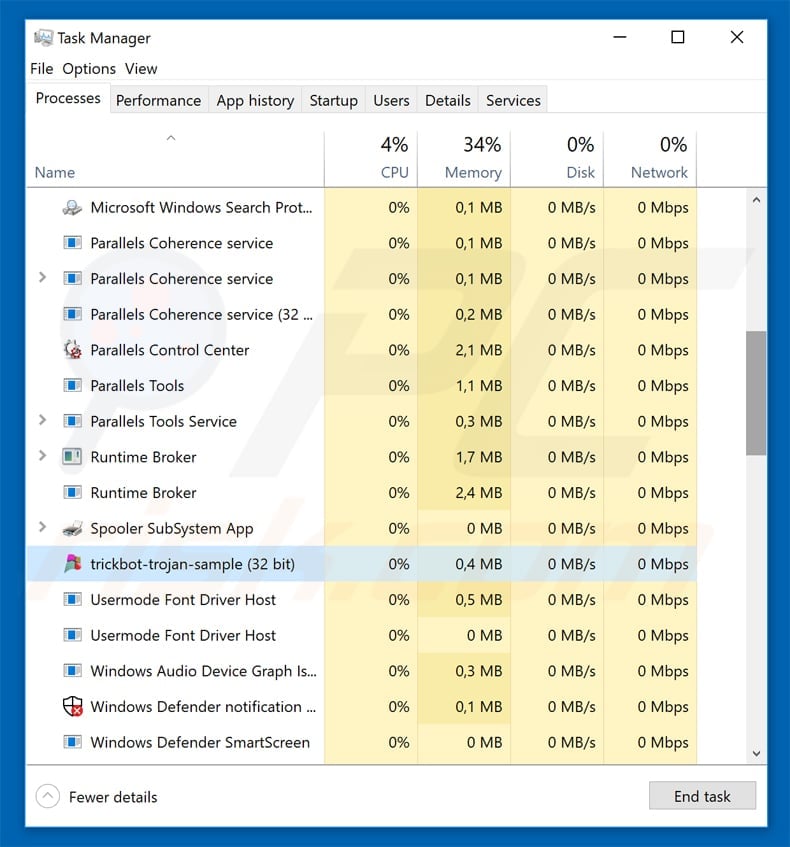
If you checked the list of programs running on your computer, for example, using task manager, and identified a program that looks suspicious, you should continue with these steps:
 Download a program called Autoruns. This program shows auto-start applications, Registry, and file system locations:
Download a program called Autoruns. This program shows auto-start applications, Registry, and file system locations:
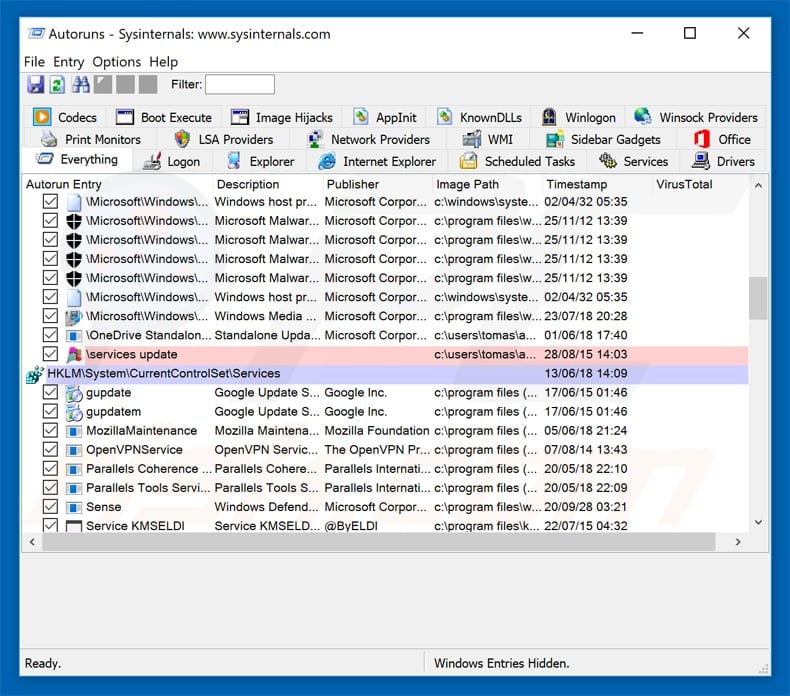
 Restart your computer into Safe Mode:
Restart your computer into Safe Mode:
Windows XP and Windows 7 users: Start your computer in Safe Mode. Click Start, click Shut Down, click Restart, click OK. During your computer start process, press the F8 key on your keyboard multiple times until you see the Windows Advanced Option menu, and then select Safe Mode with Networking from the list.

Video showing how to start Windows 7 in "Safe Mode with Networking":
Windows 8 users: Start Windows 8 is Safe Mode with Networking - Go to Windows 8 Start Screen, type Advanced, in the search results select Settings. Click Advanced startup options, in the opened "General PC Settings" window, select Advanced startup. Click the "Restart now" button.
Your computer will now restart into the "Advanced Startup options menu". Click the "Troubleshoot" button, and then click the "Advanced options" button. In the advanced option screen, click "Startup settings". Click the "Restart" button. Your PC will restart into the Startup Settings screen. Press F5 to boot in Safe Mode with Networking.
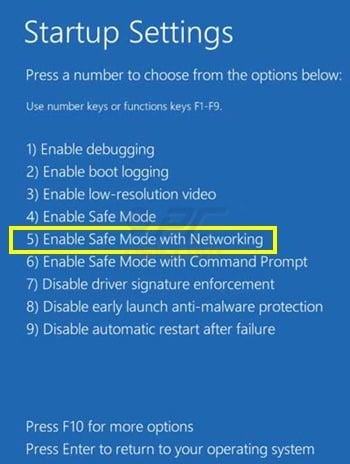
Video showing how to start Windows 8 in "Safe Mode with Networking":
Windows 10 users: Click the Windows logo and select the Power icon. In the opened menu click "Restart" while holding "Shift" button on your keyboard. In the "choose an option" window click on the "Troubleshoot", next select "Advanced options". In the advanced options menu select "Startup Settings" and click on the "Restart" button.
In the following window you should click the "F5" button on your keyboard. This will restart your operating system in safe mode with networking.
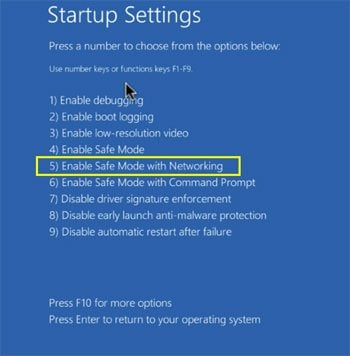
Video showing how to start Windows 10 in "Safe Mode with Networking":
 Extract the downloaded archive and run the Autoruns.exe file.
Extract the downloaded archive and run the Autoruns.exe file.
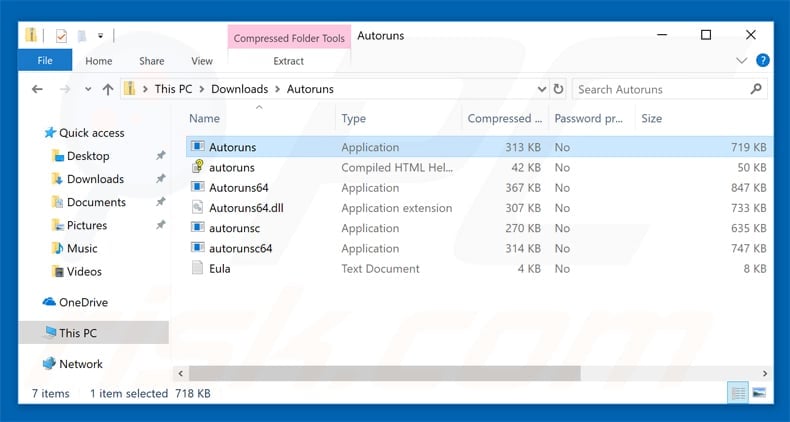
 In the Autoruns application, click "Options" at the top and uncheck the "Hide Empty Locations" and "Hide Windows Entries" options. After this procedure, click the "Refresh" icon.
In the Autoruns application, click "Options" at the top and uncheck the "Hide Empty Locations" and "Hide Windows Entries" options. After this procedure, click the "Refresh" icon.
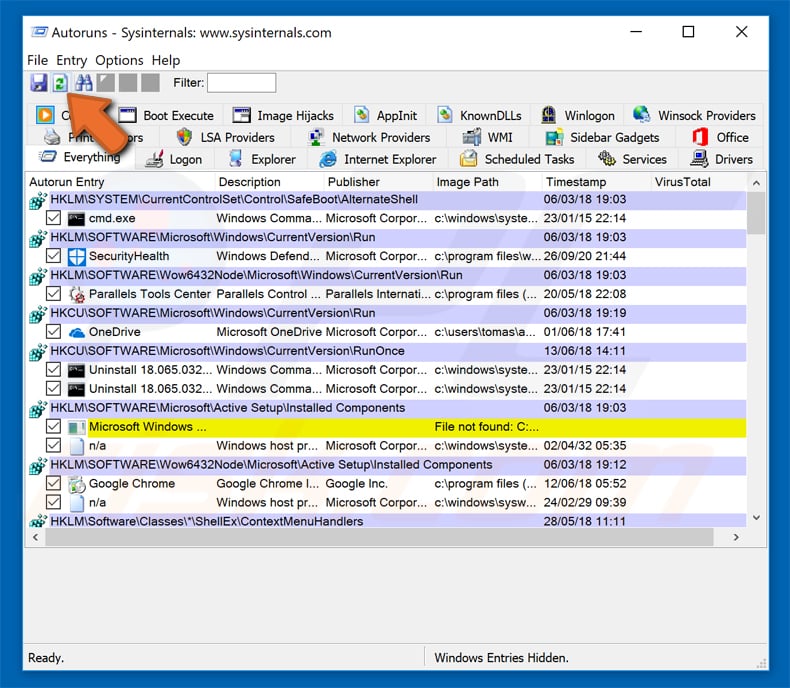
 Check the list provided by the Autoruns application and locate the malware file that you want to eliminate.
Check the list provided by the Autoruns application and locate the malware file that you want to eliminate.
You should write down its full path and name. Note that some malware hides process names under legitimate Windows process names. At this stage, it is very important to avoid removing system files. After you locate the suspicious program you wish to remove, right click your mouse over its name and choose "Delete".
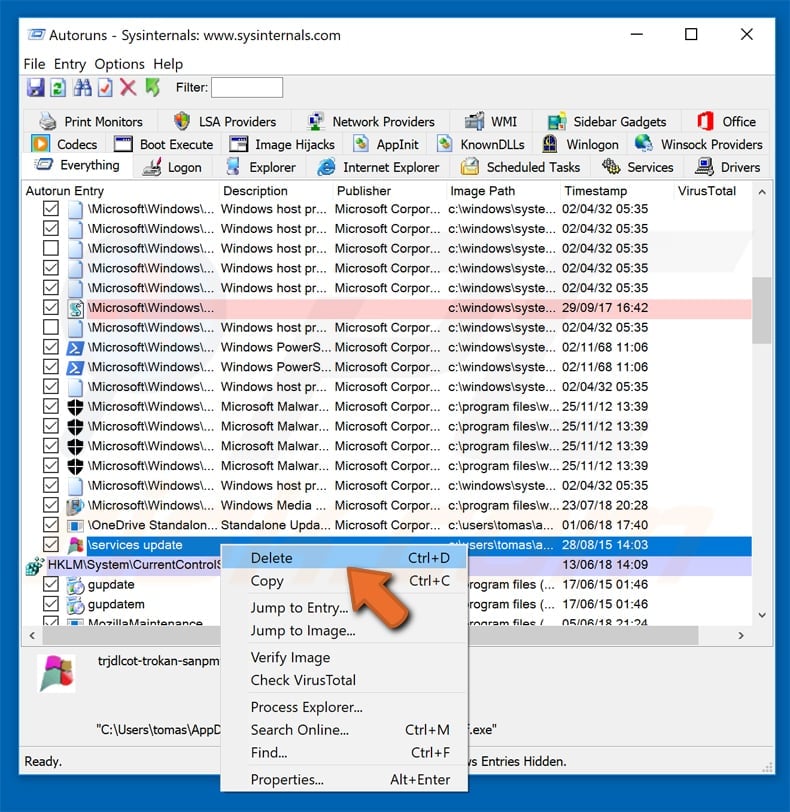
After removing the malware through the Autoruns application (this ensures that the malware will not run automatically on the next system startup), you should search for the malware name on your computer. Be sure to enable hidden files and folders before proceeding. If you find the file of the malware be sure to remove it.
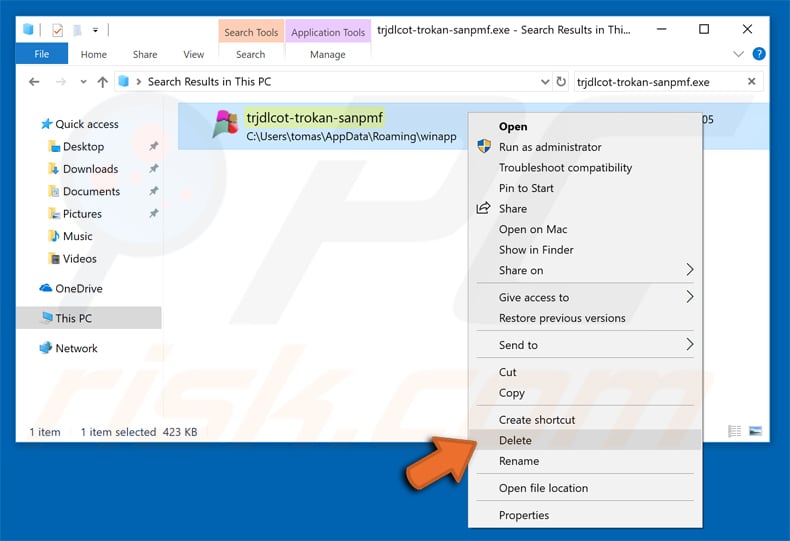
Reboot your computer in normal mode. Following these steps should remove any malware from your computer. Note that manual threat removal requires advanced computer skills. If you do not have these skills, leave malware removal to antivirus and anti-malware programs.
These steps might not work with advanced malware infections. As always it is best to prevent infection than try to remove malware later. To keep your computer safe, install the latest operating system updates and use antivirus software.
To be sure your computer is free of malware infections, we recommend scanning it with Combo Cleaner Antivirus for Windows.
Frequently Asked Questions (FAQ)
Why did I receive this email?
Spam emails are not personal. Cyber criminals distribute them in massive operations; hence, thousands of users receive identical letters.
I have provided my personal information when tricked by this spam email, what should I do?
If you have disclosed log-in credentials - change the passwords of all potentially exposed accounts and inform their official support without delay. And if you have revealed other private data (e.g., ID card details, credit card numbers, etc.) - immediately contact the corresponding authorities.
I have read a spam email but didn't open the attachment, is my computer infected?
If you have merely opened/read a spam email - no, your system was not infected. Malware download/installation processes are jumpstarted when the attachments or links found in this mail are opened/clicked.
I have downloaded and opened a file attached to a spam email, is my computer infected?
If it was an executable (.exe, .run, etc.) - most likely, yes - your system was infected. But you might have avoided triggering an infection chain if it was a document (.doc, .xls, .pdf, etc.), as these formats may require additional user interaction (e.g., enabling macro commands) to start downloading/installing malware.
Will Combo Cleaner remove malware infections present in email attachments?
Yes, Combo Cleaner is capable of detecting and eliminating most of the known malware infections. It has to be stressed that running a full system scan is paramount - as high-end malicious programs tend to hide deep within systems.
Share:

Tomas Meskauskas
Expert security researcher, professional malware analyst
I am passionate about computer security and technology. I have an experience of over 10 years working in various companies related to computer technical issue solving and Internet security. I have been working as an author and editor for pcrisk.com since 2010. Follow me on Twitter and LinkedIn to stay informed about the latest online security threats.
PCrisk security portal is brought by a company RCS LT.
Joined forces of security researchers help educate computer users about the latest online security threats. More information about the company RCS LT.
Our malware removal guides are free. However, if you want to support us you can send us a donation.
DonatePCrisk security portal is brought by a company RCS LT.
Joined forces of security researchers help educate computer users about the latest online security threats. More information about the company RCS LT.
Our malware removal guides are free. However, if you want to support us you can send us a donation.
Donate
▼ Show Discussion